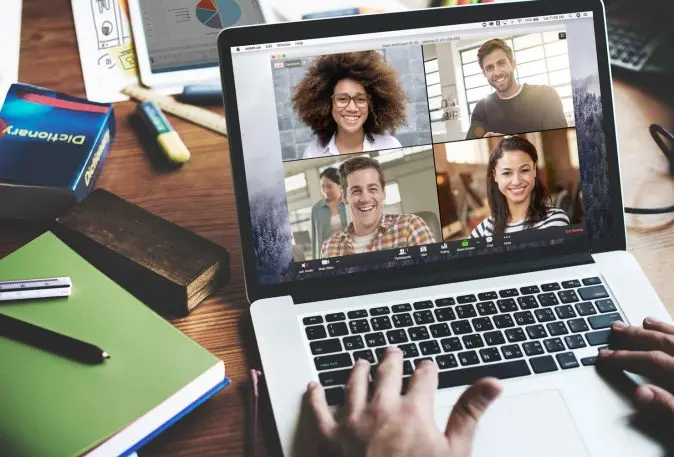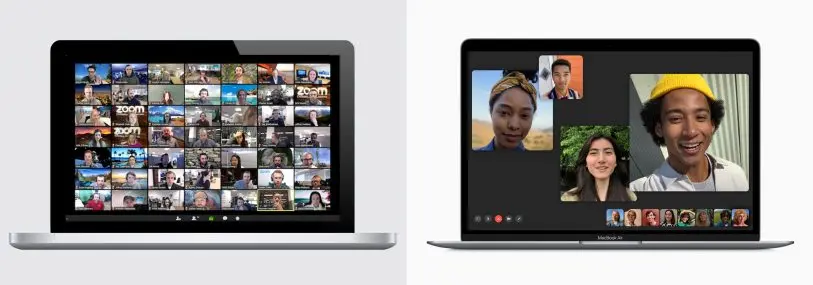The other night, I had two teleconferences scheduled at the same time. In the work world, this is an entirely normal event. But this wasn’t two business meetings I was juggling; it was the two sides of my family—both of whom wanted to connect on Zoom.
In that moment, I realized that Zoom is the social medium of COVID-19. Zoom hasn’t just conquered enterprise competitors like Webex, Bluejeans, GoToMeeting, Skype, and Adobe Connect. It has also worked its way into the social lives of people stuck at home during COVID-19. These days, people are Zooming happy hours, board game nights, and theater performances. Zoom is even replacing bars.

The platform was built to break false distinctions
Zoom broke conventions of the teleconferencing industry by eliminating the premise that important business calls only happened in a board room. The company was founded in 2011 by Eric Yuan. Yuan was an alumni of WebEx, the teleconferencing company that sold to Cisco for $3.2 billion in 2007, and he recruited other alums of the teleconferencing world to build a cloud-based product that could run with no hardware other than a laptop. That was a rarity in the industry—at the time, teleconferencing systems often had dedicated hardware. This meant Zoom wasn’t saddled with supporting old technological infrastructure.
Zoom’s creators also made a point of avoiding false distinctions in teleconferencing. As Oded Gal, chief product officer at Zoom, tells the story, both he and Yuan were frustrated working on the platform under Cisco. The platform was split. You needed one app for group conferencing calls in board rooms, and another for individuals chatting one on one.

“The idea behind Zoom was not just taking the [conference] room [remotely] as the main experience, but overall [enabling] any use case around video,” says Gal. “It was more holistic in the sense that it wasn’t focused on one use case. It was everything that was communication linked to a video conversation.” That flexibility—chat with whomever you want, on any device that you like—is at the core of Zoom’s interface and architecture. And that have-it-your-way interface is supported by decisions like making the platform both free and anonymous to try out. (Zoom makes money through corporate subscriptions; personal accounts are free.)
Which seems perfect for today’s social use cases. But Zoom never intended for the platform to be used that way. “We didn’t predict [Zoom] for the consumer world,” Gal says. “A lot of people were just sort of forced into this situation and had to comply with video communication . . . people in different age groups and cultures. It’s forced people to use such a product.” And there are good reasons why Zoom, not its many competitors, became the go-to videoconferencing service for people of all ages and backgrounds.
It’s absurdly easy to join a meeting
I’ve used Zoom for the last four years, at least twice a week, and I never set up a Zoom account until today (to do some fact-checking while writing this article). That’s because Zoom lets anyone join a meeting with a link. End stop. You don’t need to create a login (which even Google Hangouts requires). You don’t need to enter some esoteric 10-digit passcode (though pins can secure Zoom chats—and you should use them!). You don’t need to enter a credit card in case you go over their 30-minute free time limit. Anyone can simply tap a link and join a meeting.
That easy approach mattered early on in convincing IT departments and business professionals to ditch their entrenched teleconferencing systems for this startup. “When GoToMeeting, Google, Cisco, Highfive, etc. were asking you to buy specific hardware with long wait times, you could set up a Zoom room with any small PC and tablet,” says Joe Fahs, IT director at Kapor Center. “They made it easy for people who were visitors to share their screens in the conference rooms without having to use HDMI cables and adapters.”
Nine years after it was founded, Zoom’s ease of hopping into a conversation is still a major selling point that helped it go mainstream. “[The] main reason [I use Zoom] is the simplicity for people to join a Zoom meeting, just click the link basically,” a Fast Company reader who goes by shredical tweeted at us. “No registration.”
The mix of being free and anonymous to use, with the added bonus of a one-link joining system means that Zoom is incredibly welcoming for the casual user—whoever they may be. “I used to use Google Hangouts but that’s now not much of a thing, and it (or Google Meet as it is now) requires folks to have a Google account, which may prohibit some folks from using it. Zoom is easy to use, even for those who aren’t super technologically adept, and doesn’t require a sign-in unless you want them to,” says user Kate Davidson. “These are all important things to me as I try to use something with people in my church community who span the breadth of technical ability.”
The big chats offer the sensation of being in real groups
The system is built to support video streams with up to 100 concurrent users sharing video. (Google Hangouts allows a max of 10 for free, or 25 paid.) This is possible in part because Zoom doesn’t process any of the video feeds on your screen. Instead, it redirects these streams to each individual computer on the call. So it’s your phone, tablet, or laptop that’s doing all of the heavy processing around a Zoom stream—even if you’ve added a vanity filter or a custom backdrop. If Zoom weren’t built this way, the video wouldn’t just be choppy; the prospect of 100 concurrent streamers would be technically infeasible.

It might sound overwhelming to have dozens of faces on your screen at the same time, each in their own teeny tiny window. But seeing so many people you know in one spot—even your screen—has proven to be a powerful sensation as we’re all working and socializing from home. “It’s the closest thing you can get to a social gathering,” Gal says. “If you’re at a dinner or a religious ceremony . . . you’re all sitting in a holy place or around a table . . . [and] you see each other. You’re physically with the people wanting to have that experience.”
Many users agreed. “Since our marketing, web, and PR team have been working from home the past three weeks, the ‘Brady Bunch’ style gallery view helps us all feel closer together,” says Kevin G. Clark, of the company Element AI.
But this big view comes with a catch. Zoom calls can be tiring—in a phenomenon some people are dubbing “Zoom fatigue.” The main reason behind that fatigue isn’t just the meetings themselves, but that we have to work much harder to read social cues from one another on a screen than we do in person. We can also misinterpret these signals on a screen. For instance, while gaps of silence are normal in face-to-face conversation, on teleconferencing systems, a 1.2-second lull in the conversation can make it appear that people aren’t friendly or focused on the chat.
Everyone connects reliably, always
The other major reason people use Zoom is not just because it’s easy; it’s also reliable. Over the past decade, teleconferencing—in video or voice—has become something of a 90% technology. It works 90% of the time, which means at least one person in the meeting is going to be unable to connect, or have issues talking or hearing. “I’ve used just about every video conferencing platform out there,” says reader John Goodman. “My top reason for choosing Zoom is simply because it works for nearly all participants nearly all the time.”
Zoom’s spartan windows and barebones UI lacks the pizazz of competitors, like Skype. It has a single bar with mute-unmute and start-stop video buttons highlighted on the left side. In the middle, there’s one big share screen button (because it’s a popular feature people are always looking for). There are other buttons for security, chat, and emoji—though it’s easy to glance right over them. Its video feeds are rarely what I’d consider crisp or sharp. But they do work. “Having used Zoom for a while I’ve never had a call drop, or not been able to get on,” reader Lee Lam tweeted at Fast Company. As Gal explains, Zoom designed the service to always have a backup server in case the one in use went down, ensuring that a meeting never drops.
It took Zoom doing a lot of little things right
Will Zoom’s good fortune continue? Or is it the rare (and temporary) beneficiary of a global crisis? The company has faced major privacy breaches. Random users can easily reverse engineer those easy-to-share Zoom links to hijack the system’s UX, break into a private conversation, and even sabotage innocent conversations with perverse content. These are problems for consumers, but they could be devastating for the businesses that actually subscribe to Zoom, subsidizing the platform for the rest of us.
Zoom is responding to this by making all streams 256-bit encrypted and moving security settings (namely, the ability to add a passcode to a room) to the forefront of the interface. Passwords do add a step more friction to hopping in and out of rooms, and only time will tell if these updates are enough to thwart attacks on the conversations between a large number of users. A worst-case scenario for Zoom is that concerns over privacy, or design interventions to promote privacy, trump the app’s core convenience.
These problems don’t seem to be stunting Zoom’s growth right now. Zoom, in spite of its flaws, has become the social medium of the moment.
Recognize your brand’s excellence by applying to this year’s Brands That Matter Awards before the early-rate deadline, May 3.